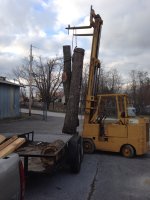4570Man
Super Star Member
- Joined
- Apr 7, 2015
- Messages
- 17,848
- Location
- Crossville, TN
- Tractor
- Kubota M59, Kubota L3800, Grasshopper 428D, Topkick dump truck, 3500 dump truck, 10 ton trailer, more lighter trailers.
Yes, but you can simply tilt the mast backwards. I forklift has pretty a decent tilt back angle which also moves the load reward as it raises. My forklift still has 2600 pounds on the rear axle with the rated capacity on the forks. On flat ground it would be pretty unlikely the you could move backwards hard enough to tip. Now, the forklift will lift more than the rated capacity which would make this possible. You would be more likely to tip it if you were moving forward and hit the brakes.Interesting. ...but as soon as you move the forklift backwards, doesn't Newton's First law say you're much more likely to tip the fork truck off it's rear wheels (that is: the horizontal force required to move the raised load backwards has a torque effect about the front axle that is multiplied by this raised height?)
